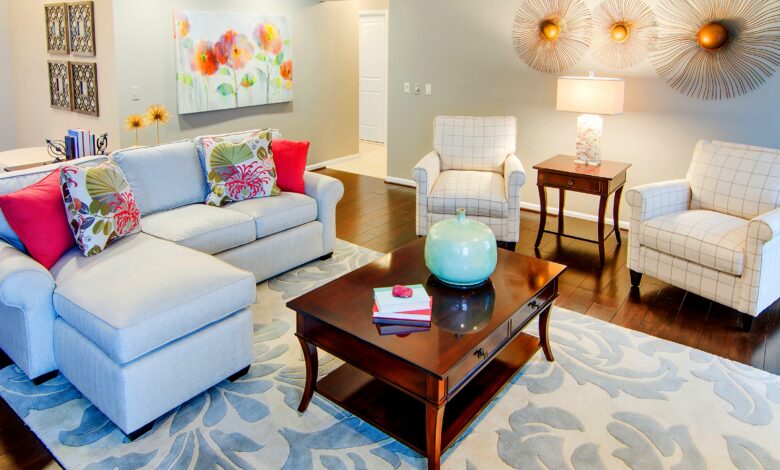How to Transition Your Decor Seamlessly Between Seasons
his comprehensive guide will walk you through practical, creative, and budget-friendly ways to transition your decor seamlessly, incorporating seasonal elements.

Transitioning your home decor between seasons is a delightful way to keep your living space fresh, inviting, and aligned with the changing rhythms of nature. As the seasons shift, so do our moods, activities, and aesthetic preferences. Whether you’re welcoming the crisp air of fall, the cozy warmth of winter, the vibrant renewal of spring, or the breezy lightness of summer, knowing how to transition your decor can make your home feel harmonious and stylish year-round. This comprehensive guide will walk you through practical, creative, and budget-friendly ways to transition your decor seamlessly, incorporating seasonal elements while maintaining a cohesive look.
Why Transitioning Your Decor Matters
Your home is a reflection of your personality and lifestyle, and seasonal decor changes allow you to express both while adapting to the environment. Transitioning your decor enhances comfort, creates a welcoming atmosphere, and keeps your space visually appealing. It’s not about overhauling your entire home but making intentional, subtle adjustments that celebrate the season’s unique charm. From swapping out textiles to adding natural elements, learning to transition your decor ensures your home feels relevant and cozy no matter the time of year.
Benefits of Seasonal Decor Transitions
- Enhanced Ambiance: Seasonal decor creates a mood that resonates with the time of year, such as cozy blankets in winter or bright florals in spring.
- Cost-Effective Updates: Small changes like throw pillows or wreaths can refresh your space without breaking the bank.
- Personal Expression: Seasonal decor lets you showcase your creativity and personality.
- Connection to Nature: Incorporating seasonal elements like pumpkins or seashells ties your home to the natural world.
- Improved Well-Being: A refreshed space can boost your mood and make your home feel more inviting.
Planning Your Seasonal Decor Transition
Before diving into specific tips, it’s essential to approach seasonal decor changes strategically. A well-planned transition ensures your home remains cohesive and functional. Here’s how to start:
1. Assess Your Current Decor
Take stock of your existing decor to identify elements that can stay year-round and those that can be swapped out. Neutral furniture pieces, like a classic sofa or dining table, serve as a timeless foundation, making it easier to transition your decor with accessories. Look for items that can be stored or repurposed, such as throw blankets, pillows, or wall art.
2. Create a Seasonal Color Palette
Each season has a distinct color palette that can guide your decor choices. For example:
- Spring: Pastels like blush pink, mint green, and soft yellow.
- Summer: Bright whites, aqua blues, and sunny yellows.
- Fall: Warm tones like burnt orange, deep red, and mustard yellow.
- Winter: Cool blues, silvers, and creamy whites.
Choose a palette that complements your home’s existing colors to ensure a seamless transition. For instance, if your living room has neutral tones, you can transition your decor by adding pops of seasonal color through accessories like cushions or table runners.
3. Invest in Versatile Pieces
To make seasonal transitions effortless, invest in versatile decor items that can be styled differently throughout the year. Examples include:
- Neutral throw blankets that can be layered with seasonal patterns.
- Glass vases that can hold spring flowers, summer seashells, or winter pinecones.
- Wooden trays that can display seasonal items like pumpkins or ornaments.
These pieces act as a canvas, allowing you to transition your decor without needing to purchase new items each season.
4. Plan for Storage
Seasonal decor requires storage solutions to keep items organized and in good condition. Use labeled bins or vacuum-sealed bags to store off-season items like holiday lights or summer linens. This makes it easier to transition your decor when the next season arrives.
Spring: Refresh and Renew
Spring is all about renewal, growth, and light. To transition your decor for spring, focus on brightening your space and incorporating natural elements that evoke freshness.
Key Elements for Spring Decor
- Floral Accents: Add fresh or faux flowers like tulips, daffodils, or peonies in vases or as table centerpieces.
- Light Textiles: Swap heavy winter blankets for lightweight cotton or linen throws in pastel hues.
- Greenery: Introduce potted plants or herbs to bring the outdoors in.
- Soft Colors: Use pillows, rugs, or curtains in shades like lavender, mint, or baby blue.
Practical Tips
- Update Your Entryway: Create a welcoming spring vibe with a floral wreath or a basket of fresh greenery.
- Refresh Bedding: Switch to breathable cotton sheets and add a lightweight quilt in a soft color.
- Incorporate Natural Light: Replace heavy drapes with sheer curtains to let in more sunlight.
- Add Scents: Use candles or diffusers with scents like lavender or citrus to enhance the spring atmosphere.
By focusing on light, airy elements, you can transition your decor to reflect spring’s vibrancy while maintaining a cohesive look.
Summer: Bright and Breezy
Summer decor is all about embracing warmth, relaxation, and outdoor living. To transition your decor for summer, incorporate elements that feel fresh, vibrant, and carefree.
Key Elements for Summer Decor
- Nautical Touches: Think coastal-inspired decor like seashells, driftwood, or striped pillows.
- Bright Colors: Use bold hues like coral, turquoise, or sunny yellow to evoke summer’s energy.
- Outdoor Integration: Bring indoor furniture to patios or decks for seamless indoor-outdoor living.
- Light Fabrics: Opt for linen or cotton curtains, cushions, and tablecloths.
Practical Tips
- Create an Outdoor Oasis: Add string lights, lanterns, or colorful cushions to your patio to extend your living space.
- Incorporate Tropical Elements: Use pineapple motifs, palm leaf prints, or wicker accents for a summery vibe.
- Switch Tableware: Use colorful plates or glassware to reflect summer’s playful spirit.
- Add Fresh Scents: Choose candles or air fresheners with scents like coconut, sea breeze, or mango.
These changes allow you to transition your decor effortlessly, creating a space that feels open and inviting for summer gatherings.
Fall: Warm and Cozy
Fall is the season of warmth, harvest, and coziness. To transition your decor for fall, focus on rich textures, warm colors, and natural elements that celebrate the season.
Key Elements for Fall Decor
- Warm Textures: Layer throw blankets, wool rugs, and knitted cushions in earthy tones.
- Harvest Elements: Incorporate pumpkins, gourds, or dried corn as table centerpieces or mantel decor.
- Rich Colors: Use shades like burnt orange, deep red, or olive green for accents.
- Ambient Lighting: Add candles or fairy lights for a cozy glow.
Practical Tips
- Update Your Mantel: Create a fall display with pumpkins, leaves, and candles.
- Swap Pillows and Throws: Choose plaid or solid-colored cushions in warm hues.
- Incorporate Natural Elements: Use branches, acorns, or pinecones in vases or bowls.
- Scent the Space: Use candles with scents like cinnamon, apple pie, or pumpkin spice.
By embracing fall’s warmth and texture, you can transition your decor to create a cozy, inviting atmosphere perfect for crisp autumn days.
How to Transition Your Decor Seamlessly Between Seasons
Transitioning your home decor between seasons is a creative and rewarding way to keep your living space fresh, inviting, and in harmony with the changing environment. Whether you’re embracing the vibrant blooms of spring, the breezy vibes of summer, the cozy warmth of fall, or the serene elegance of winter, learning how to transition your decor ensures your home reflects the season’s unique charm.
Why Transition Your Decor Seasonally?
Your home is a reflection of your personality, and seasonal decor changes allow you to express your style while adapting to the natural rhythms of the year. Transitioning your decor enhances comfort, creates a welcoming atmosphere, and keeps your space visually dynamic. It’s not about a complete overhaul but making intentional, subtle adjustments that celebrate each season. Here’s why you should transition your decor:
- Enhanced Ambiance: Seasonal decor sets a mood that aligns with the time of year, from cozy winter layers to bright summer accents.
- Cost-Effective Updates: Small changes like pillows or wreaths can refresh your space affordably.
- Personal Expression: Seasonal styling showcases your creativity and individuality.
- Connection to Nature: Elements like pumpkins or seashells tie your home to the outdoors.
- Improved Well-Being: A refreshed space boosts mood and makes your home more inviting.
Planning Your Seasonal Decor Transition
To transition your decor effectively, a strategic approach ensures cohesion and functionality. Here’s how to plan your seasonal updates:
1. Assess Your Current Decor
Evaluate your existing decor to identify versatile, year-round pieces and items that can be swapped seasonally. Neutral furniture, like a classic sofa or wooden table, serves as a timeless foundation, making it easier to transition your decor with accessories like throws, pillows, or wall art.
2. Create a Seasonal Color Palette
Each season has a distinct color palette to guide your decor choices:
- Spring: Pastels like blush pink, mint green, and soft yellow.
- Summer: Bright whites, aqua blues, and sunny yellows.
- Fall: Warm tones like burnt orange, deep red, and mustard yellow.
- Winter: Cool blues, silvers, and creamy whites.
Choose colors that complement your home’s existing palette to transition your decor seamlessly. For example, a neutral living room can be accented with seasonal pops of color through cushions or rugs.
3. Invest in Versatile Pieces
Versatile decor items simplify seasonal transitions. Consider:
- Neutral throw blankets that can be layered with seasonal patterns.
- Glass vases that can hold spring flowers, summer shells, or winter pinecones.
- Wooden trays for displaying seasonal items like pumpkins or ornaments.
These pieces act as a canvas, allowing you to transition your decor without purchasing new items each season.
4. Plan for Storage
Organized storage is key to managing seasonal decor. Use labeled bins or vacuum-sealed bags to store off-season items like holiday lights or summer linens, making it easier to transition your decor when the next season arrives.
5. Set a Budget
Seasonal decor doesn’t have to be expensive. Set a budget for key items like pillows, wreaths, or candles, and focus on versatile pieces that can be reused. DIY projects can also help you transition your decor affordably.
Spring: Refresh and Renew
Spring is a season of renewal, growth, and light. To transition your decor for spring, focus on bright, airy elements that evoke freshness and vitality.
Key Elements for Spring Decor
- Floral Accents: Fresh or faux flowers like tulips, daffodils, or peonies in vases or centerpieces.
- Light Textiles: Lightweight cotton or linen throws in pastel hues.
- Greenery: Potted plants or herbs to bring the outdoors in.
- Soft Colors: Pillows, rugs, or curtains in lavender, mint, or baby blue.
Practical Tips to Transition Your Decor
- Update Your Entryway: A floral wreath or basket of greenery creates a welcoming spring vibe.
- Refresh Bedding: Switch to breathable cotton sheets and a lightweight quilt in soft colors.
- Maximize Natural Light: Replace heavy drapes with sheer curtains to brighten your space.
- Incorporate Scents: Use lavender or citrus candles to enhance the spring atmosphere.
By focusing on light, natural elements, you can transition your decor to reflect spring’s vibrant energy while maintaining a cohesive aesthetic.
Summer: Bright and Breezy
Summer decor embraces warmth, relaxation, and outdoor living. To transition your decor for summer, incorporate vibrant, carefree elements that reflect the season’s energy.
Key Elements for Summer Decor
- Nautical Touches: Coastal-inspired items like seashells, driftwood, or striped pillows.
- Bright Colors: Coral, turquoise, or sunny yellow accents for a lively feel.
- Outdoor Integration: Extend indoor furniture to patios or decks for indoor-outdoor living.
- Light Fabrics: Linen or cotton curtains, cushions, and tablecloths.
Practical Tips to Transition Your Decor
- Create an Outdoor Oasis: Add string lights, lanterns, or colorful cushions to your patio.
- Incorporate Tropical Elements: Use pineapple motifs, palm leaf prints, or wicker accents.
- Switch Tableware: Use colorful plates or glassware for a playful summer vibe.
- Add Fresh Scents: Choose coconut, sea breeze, or mango-scented candles.
These changes allow you to transition your decor to create an open, inviting space for summer gatherings.
Fall: Warm and Cozy
Fall is the season of warmth, harvest, and coziness. To transition your decor for fall, focus on rich textures, warm colors, and natural elements.
Key Elements for Fall Decor
- Warm Textures: Layer throw blankets, wool rugs, and knitted cushions in earthy tones.
- Harvest Elements: Pumpkins, gourds, or dried corn as centerpieces or mantel decor.
- Rich Colors: Burnt orange, deep red, or olive green accents.
- Ambient Lighting: Candles or fairy lights for a cozy glow.
Practical Tips to Transition Your Decor
- Update Your Mantel: Create a fall display with pumpkins, leaves, and candles.
- Swap Pillows and Throws: Choose plaid or solid-colored cushions in warm hues.
- Incorporate Natural Elements: Use branches, acorns, or pinecones in vases or bowls.
- Scent the Space: Use cinnamon, apple pie, or pumpkin spice candles.
Embracing fall’s warmth and texture helps you transition your decor to create a cozy, inviting atmosphere.
Winter: Elegant and Serene
Winter decor focuses on creating a warm, elegant, and serene retreat. To transition your decor for winter, incorporate elements that evoke comfort and sophistication.
Key Elements for Winter Decor
- Metallic Accents: Silver, gold, or bronze touches in candle holders or vases.
- Cozy Textiles: Faux fur throws, velvet pillows, or wool blankets.
- Evergreen Elements: Pinecones, wreaths, or garlands for a festive touch.
- Cool Colors: Blues, silvers, and whites for a serene vibe.
Practical Tips to Transition Your Decor
- Create a Cozy Nook: Add plush blankets and pillows to a reading corner.
- Update Lighting: Use warm-toned bulbs or string lights for ambiance.
- Incorporate Festive Elements: Add subtle holiday decor like ornaments or a small tree.
- Use Winter Scents: Choose candles with scents like pine, cedar, or vanilla.
These elements help you transition your decor to create a winter haven that’s both elegant and cozy.
Budget-Friendly Tips to Transition Your Decor
Transitioning your decor doesn’t have to be expensive. Here are cost-effective ways to update your home seasonally:
- DIY Projects: Create wreaths, centerpieces, or painted mason jars for seasonal flair.
- Shop Secondhand: Find unique decor items at thrift stores or flea markets.
- Repurpose Items: Use existing decor in new ways, like filling vases with seasonal items.
- Focus on Small Changes: Swap out pillows, throws, or candles for a big impact.
These strategies make it affordable to transition your decor while keeping your home stylish.
Maintaining Cohesion Across Seasons
To ensure your home remains cohesive as you transition your decor, follow these tips:
- Stick to a Core Palette: Use a neutral base to make seasonal colors pop.
- Balance Trends and Timelessness: Mix trendy seasonal items with classic pieces.
- Use Consistent Textures: Repeat textures like wood or metal across seasons.
- Layer Thoughtfully: Layer seasonal items without cluttering your space.
This approach ensures your home feels unified as you transition your decor throughout the year.
Room-by-Room Seasonal Decor Ideas
Living Room
- Spring: Add pastel pillows and a floral rug.
- Summer: Use nautical throws and seashell decor.
- Fall: Layer cozy blankets and pumpkin accents.
- Winter: Add metallic candle holders and faux fur throws.
Kitchen
- Spring: Display fresh herbs or floral table runners.
- Summer: Use bright dishware and tropical napkins.
- Fall: Add a harvest-themed centerpiece.
- Winter: Use silver or gold utensils for elegance.
Bedroom
- Spring: Switch to lightweight, pastel bedding.
- Summer: Use airy linens and coastal accents.
- Fall: Add warm throws and plaid pillows.
- Winter: Layer plush blankets and velvet cushions.
Bathroom
- Spring: Use floral towels and pastel mats.
- Summer: Add seashell soap dishes or blue towels.
- Fall: Use earthy-toned accessories.
- Winter: Incorporate metallic accents and white towels.
These room-specific ideas make it easy to transition your decor throughout your home.
Sustainable Seasonal Decor
Sustainability is key when transitioning your decor. Consider eco-friendly options:
- Natural Materials: Use wood, cotton, or linen decor items.
- Reusable Items: Choose decor that can be repurposed each season.
- Secondhand Finds: Shop at thrift stores for unique, sustainable pieces.
- DIY Upcycling: Transform old items into seasonal decor.
Sustainable choices align with modern interior design trends and make it easier to transition your decor responsibly.
Common Mistakes to Avoid
- Overloading on Decor: Too many seasonal items can clutter your space.
- Ignoring Functionality: Ensure decor doesn’t disrupt daily life.
- Clashing Colors: Stick to a cohesive palette to avoid chaos.
- Neglecting Storage: Plan for off-season storage to keep items in good condition.
Avoiding these pitfalls ensures a smooth process to transition your decor.
Final Thoughts
Learning how to transition your decor seamlessly between seasons is a rewarding way to keep your home fresh, stylish, and inviting. By planning strategically, using versatile pieces, and incorporating seasonal colors, textures, and elements, you can create a cohesive, beautiful space year-round. Whether you’re adding spring florals, summer nautical touches, fall pumpkins, or winter metallics, small changes can make a big impact. With these tips, you can transition your decor effortlessly, creating a home that reflects your style and the beauty of each season.










